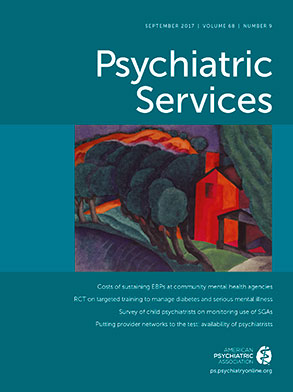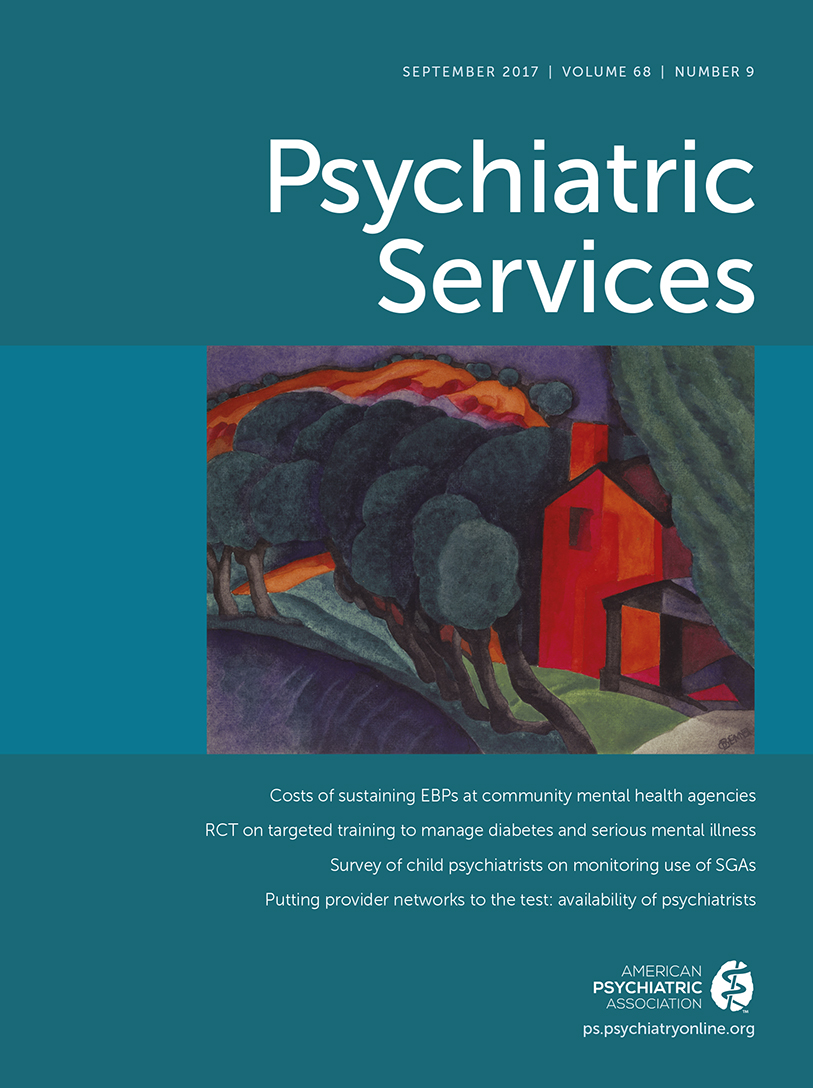Throughout the United States, there is a significant need for behavioral health providers who are educated, certified, and licensed to provide the full scope of mental health services, including evaluation, diagnosis, and prescription of psychotropic medications (
1). Some 4,000 whole or partial U.S. counties have been identified as areas where shortages of mental health professionals exist—regions with less than one psychiatrist per 30,000 people (
2). Because psychiatric mental health advanced practice nurses (PMH APNs) are educated, credentialed, and licensed to provide the full range of mental health services (assessment, diagnosis, treatment, and prescribing), they are recognized as providers who effectively address the shortage of psychiatrists (
3), particularly for individuals struggling with complex mental health and social issues (
4).
Unfortunately, consideration of how PMH APNs might increase access to mental health services is impeded by misrepresentation of the specialty in public documents (
5), workforce studies that depict PMH APNs as a group declining in size (
1), and federal reports that inaccurately define PMH APNs’ scope of practice (
6). These inaccuracies hinder mental health workforce planning, particularly in regard to developing models of care in which each member of the interprofessional team practices to the full extent of his or her education and training (
7). The purpose of this Open Forum is to provide an accurate depiction of the PMH APN workforce, its current size, its scope of practice, and its capacity to increase access to mental health services.
Description of the PMH APN Workforce
PMH APNs hold an R.N. degree and have completed a graduate nursing degree focused on psychiatric nursing, a degree that encompasses education in multiple sciences (pathophysiology, pharmacology, psychiatry, neuroscience, and psychotherapeutic techniques). For 60 years, PMH APNs were licensed and certified as PMH clinical nurse specialists (CNSs). Because PMH CNS graduate coursework was similar to the emerging PMH nurse practitioner (NP) curriculum, and because NPs had wider recognition as direct care providers, PMH CNS programs began in 2001 to align their curricula to a PMH NP educational model. This transition was hastened by national APN consensus guidelines that systematized the role delineation and educational preparation of PMH APNs as practitioners prepared to address mental health needs across the lifespan (
8).
Now all PMH APN programs are NP focused, and there are no longer new PMH CNSs entering the workforce. However, these APNs continue to be a vital and significant portion of the PMH APN workforce, particularly given that the vast majority of PMH CNSs provide direct care psychiatric services, such as assessments. Although PMH CNSs and PMH NPs practice under the same national scope of practice, PMH CNS privileges may vary depending on state laws, particularly in the area of prescribing. All states allow PMH NPs to prescribe, but ten states restrict CNS prescribing (
9). Nevertheless, the PMH APN workforce should include both certified PMH CNSs and PMH NPs—that is, nurses who hold a PMH APN certification from the American Nurses Credentialing Center. The current number of certified PMH APNs is 13,815 (
10). This includes 8,887 nurses who hold PMH NP certifications (adult and lifespan), together with 4,928 nurses who hold PMH CNS certifications (adult and child) (duplicate certifications removed from publicly reported data).
Educational Pipeline of PMH APNs
Currently, 118 graduate nursing programs in the United States offer the PMH NP degree, and all PMH CNS programs have been discontinued. The PMH NP can be awarded at the master’s or doctoral level. In the past ten years, there has been a national effort to move NP education to the doctoral level, but a doctorate is not required for certification or state licensure. PMH NP programs follow competencies set down by the National Organization of Nurse Practitioner Faculties, which are developed by expert NP panels and then vetted by large numbers of NP faculty throughout the country. These national competencies direct PMH NP graduate programs to educate students to conduct comprehensive assessments, diagnosis, and treatment planning, to deliver evidence-based interventions and patient education, to prescribe medications, and to conduct treatment evaluation at both the individual and the systemwide quality levels (
11).
Currently, there are 4,950 students enrolled in PMH NP programs at the master’s or doctoral level (
12). This represents a 26% increase in enrolled students since 2014–2015. For the past five years, approximately 1,100 PMH NPs per year have successfully passed their national certification exam (
10). This rate puts the specialty on target to reach the Health Resources and Services Administration’s estimate that by 2025 the PMH NP workforce will be 17,900 (
13). Even with that growth, the PMH NP workforce will likely remain a small percentage of the total NP population because PMH NPs currently represent about 4.5% of the 200,000 licensed NPs.
State Distribution and Scope of Practice
The density of PMH APNs differs from state to state. Particular states—primarily states in the Northeast—have a high density of PMH APNs, and states such as Oklahoma, California, Nevada, Illinois, and Texas have a low density (
5). Within each state, accessibility of PMH APN providers depends on both the setting (urban versus rural) and the number of uninsured individuals in a region. In completely rural areas of full-practice states (see below), nonphysician clinicians (APNs and physician assistants) constitute the largest share of the total accessible primary care workforce (
14). Another important element in the density of PMH APNs in a state is the availability of PMH APN education. States with no PMH graduate nursing programs or only one such program (for example, Oklahoma, Nevada, and South Carolina) have a low density of PMH APNs, and states with several programs (for example, Massachusetts and Connecticut) have more PMH APNs. The ratio of PMH APNs to the state census matters. Therefore, although high-census states, such as New York, have a strong cohort of APNs and several PMH NP graduate programs, the numbers are not sufficient for that population-dense state.
The range of services APNs are able to provide is largely directed by state scope-of-practice laws, which also determine the extent to which an APN can practice independently—that is, can treat and prescribe medications without physician supervision or collaboration. Currently, 22 states plus the District of Columbia have full-practice authority, allowing PMH NPs to diagnosis, treat, order diagnostic tests, and prescribe to patients without physician oversight but under the authority of the state board of nursing (
9). Seventeen states have some restrictions on practice, as either an element of NP practice or the requirement of a regulated collaborative agreement; the remaining states have restricted-practice regulations, which direct a level of supervision for NP practice. CNS practice authority differs from that of NPs in eight states (
9). In a recent review of the impact of scope-of-practice laws on access to care and health care utilization, the authors concluded that states that allow greater SOP authority tend to have larger numbers and growth of NPs and greater use of health care, particularly among rural and vulnerable populations in these states (
15).
PMH NP Practice and Access to Care
Expanding the use of PMH APNs would increase access to mental health services for several reasons. One issue restricting access to mental health services is the shortage of psychiatrists (
1). Because PMH APNs are licensed to provide the full range of diagnostic and treatment services, including pharmacotherapy, use of PMH APNs expands access by increasing the number of providers with a comprehensive scope of practice (
2). The transportability of PMH APN skills to various settings and modalities also increases availability of services. For example, use of telemedicine in the Veterans Health Administration effectively utilized both psychiatrists and PMH NPs to provide individual psychotherapy within medication management over five years to approximately 140,000 individuals (
16). Although provider capacity is one component of access, service availability can be enhanced by innovations in service delivery, such as team-based integrated models of care. In a study of 27 practices that used integrated team-based care (TBC), which included PMH APNs, the TBC model increased access to care and quality in a large health system (
17).
Increasingly, integrated care is organized by the collaborative care model, a service innovation emphasizing care coordination, self-management support, and use of interprofessional TBC models in which each provider practices to the top of his or her education and training (
18). PMH APNs could increase the reach of these collaborative care models, because their education and training prepare them to attend to both the general medical and the mental health needs of clients. PMH APNs also bring a patient-centered approach that places the needs of the whole person at the center of care (
4). This holistic approach emphasizes prevention, social well-being, and population health, thus providing a critical orientation to address the health care needs of rural Americans and the underserved (
19). In managed care payment arrangements, PMH APNs will be an asset in tracking patient progress toward defined outcomes, implementing quality improvement efforts, and addressing mental health needs within the broader socioeconomic context (
18).
Each of the core mental health professions (psychiatrists, nurses, psychologists, counselors and social workers) has a unique set of competencies to bring to mental health care. However, there is a critical need to utilize mental health providers such as PMH APNs, who are certified to provide the full scope of mental health services, including prescribing. Clear delineation of roles will create interprofessional teams that create effective mental health services with greater reach to individuals in need. The capabilities of PMH APNs will allow them to play an important role on these teams, as state health care planners and health systems map out strategies to increase access to mental health services for populations and communities.
Acknowledgments
The author thanks Nicholas Croce, Jr., M.S., American Psychiatric Nurses Association, for help with obtaining and tracking workforce data.

